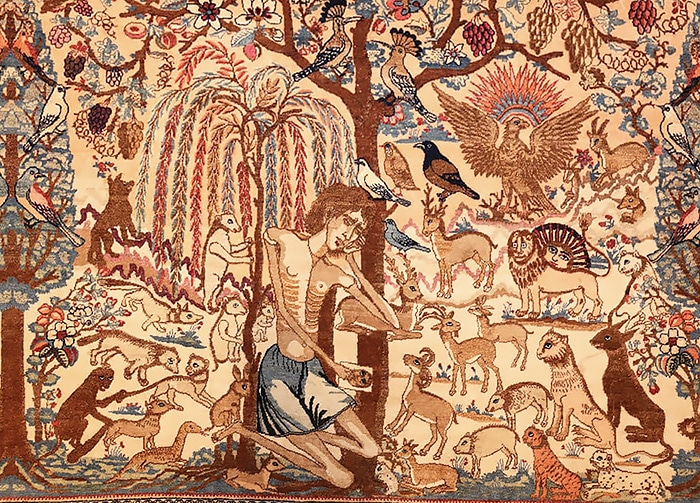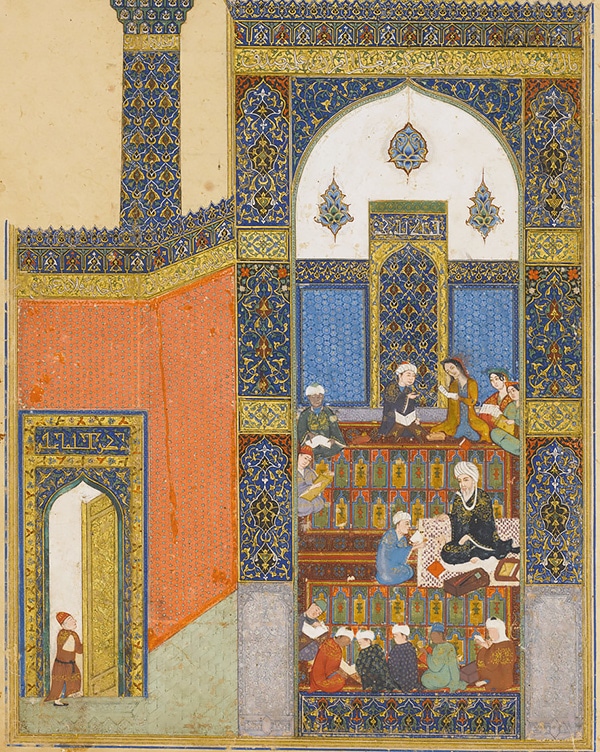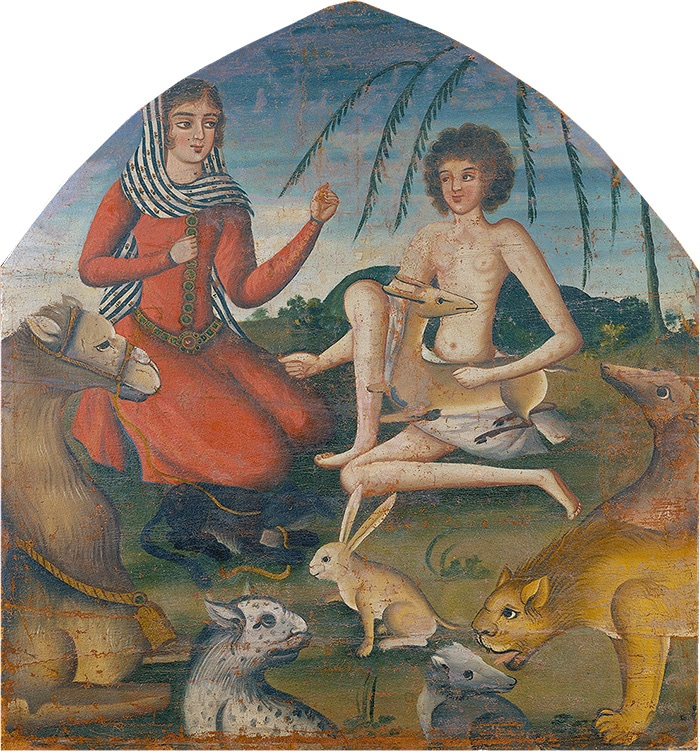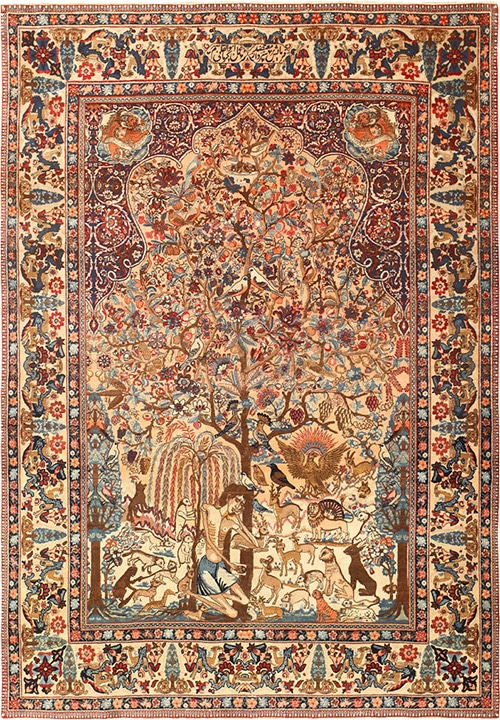Nizami’s Iconic and Tragic Persian Love Story Of Layla and Majnun
For starters, lets take a look at who Nizami Ganjavi was
Nizami Ganjavi, often simply referred to as Nizami, was a renowned Persian poet and writer who lived during the 12th century. He was born around 1141 in Ganja, which is now located in modern-day Azerbaijan. Nizami is considered one of the greatest figures in Persian literature and is known for his contributions to various poetic genres, including epic poetry, romantic literature, and philosophical allegory.
Nizami’s most famous works include:
- “Khosrow and Shirin”: This is a romantic epic that tells the story of the love between the Sassanian king Khosrow II and the Armenian princess Shirin. The poem is known for its intricate narrative structure, vivid descriptions, and exploration of themes such as love, loyalty, and fate.
- “Layla and Majnun”: Nizami’s version of the classic Arabian love story “Layla and Majnun” is one of the most celebrated renditions of this tale. It portrays the tragic love between Qays ibn al-Mulawwah (Majnun) and Layla, and it explores themes of unrequited love and spiritual devotion.
- “Eskandar-nameh” (The Book of Alexander): This is an epic poem that narrates the life and conquests of Alexander the Great. Nizami’s version of the story includes both historical and mythical elements and is known for its moral and philosophical reflections.
- “Haft Peykar” (The Seven Beauties): This work is a philosophical romance that centers around the adventures of Bahram Gur, a Sassanian prince. Each of the seven sections of the poem presents a different aspect of wisdom and knowledge, reflecting Nizami’s interest in moral and ethical themes.
- “Makhzan al-Asrar” (The Treasury of Secrets): This poem explores the mystical and philosophical teachings of Sufism, a mystical branch of Islam. It delves into themes of spiritual enlightenment, love for God, and the pursuit of inner truth.
Nizami’s works have had a profound influence on Persian literature and culture, as well as on subsequent generations of poets and writers. His innovative storytelling techniques, lyrical language, and depth of thought continue to be celebrated and studied to this day.
Layla and Majnun by Nizami
This tragic love story has the well recognized theme of young love, separation and meddling parents. But this story is not about Romeo and Juliet nor was it written by William Shakespeare. This is the old and tragic Persian love story of Layla and Majnun, two lovers who’s separation did not temper their love, devotion, infatuation or obsession.
Lord Byron, however, did once refer to the story of Layla and Majnun as the Eastern version of Shakespeare’s Romeo and Juliet. While an apt comparison in content, this is also a misleading statement since it infers to readers that “Layla and Majnun” was written after “Romeo and Juliet” in a mocking fashion, which is not the case. Like “Romeo and Juliet,” though, the idea behind the story had been around for some time before William Shakespeare (1564 – 1616) and Persia’s Nizami Ganjavi (1141 – 1209) made their respective stories iconic pieces of literary history.

Heart Broken Majnun Bonds With The Beasts – 19th Century Persian Carpet By Master Weaver Aboul Ghasem Kermani
A little known fact is that the plot of “Romeo and Juliet” was actually based on an Italian tale called “The Tragical History of Romeus and Juliet” which was written by Arthur Brooke in 1562 . This Italian tale was around long before Shakespeare expanded and developed it to become the iconic story of “Romeo and Juliet” that readers know today. Naturally, after Shakespeare’s work, there have also been numerous re-telling and adaptions of this version of the story as well.
The Influence Of The Nizami Persian Love Story Of Layla and Majnun
Nizami’s 12th century poetic composition of “Layla and Majnun” is a similar case to “Romeo and Juliet,” both before and after. Nezami’s narrative influenced a number of allusions and references in the subsequent centuries, such as Amir Khusraw Dehlawi’s 1299 “Majnun and Laili,” Abd al-Rahman Jami’s 1485 “Laili and Majnun,” and a number of films. Layla’s and Majnun’s story has been reinterpreted via many languages and throughout many poems, plays, paintings, songs, and musical compositions. The latest of which is a 70 minute long musical and dance production by director and choreographer Mark Morris.
In Persia, poets Rudaki and Baba Taher mention the lovers in their 9th century works, but the concept of the story had already been known as far back as fifth century Arabic literature. It might’ve been a long standing anecdotal legend before Persia’s Nizami Ganjavi made his unique composition. But Nizami was the first person to vividly and extensively developed the plot and characters. His work also drew from existing Udhrite love poetry and epics like the 11th century “ Vamiq u ‘Adhra.”
Nonetheless, the main concept of previous works had only loosely connected and barely developed the these concepts. Albeit, they also focused on the same erotic abandon, unfulfilled longing, and passionate displays of love and devotion that Nizami, who also penned the tragic Persian love story Of Shirin and Khosrow, carried forward in his poetic masterpiece.
To many readers, Nizami’s addition reshaped the legends of Majnun. Nizami’s Majnun was transformed from a crudely described romantic fool, in a setting with a barely scratched surface, into the detailed quintessential tale of an idealized love story.
Nizami’s Tragic Persian Love Story Of Layla And Majnun
The story starts as the Banu ‘Amir tribe’s (for centuries after the rise of Islam, the ancient Banu Amir tribes, who originated in the southwest / central part of Arabia, dominated the area) young Qays ibn al-Mulawwah falls deeply in love with Layla bint Sa‘d, a classmate of his at maktab. As they age, Layla’s and Qays’ love develops and expounds to heights not acceptable by society.

“Laila and Majnun at School” – Afghanistan Herat 15th Century Jafar Baisunghuri Illustrated Manuscript Of At Met Museum
Layla’s love is a quiet profession of feelings. In stark contrast, Qays is without filter as he very publicly, incessantly and obsessively announces his passions, in elegiac lyrics, for all to hear. He thus his spectators give him the nickname “Majnun”, which means “a crazy person” or a person who is possessed.
Majnun continues his public poetic love professions and rants on Layla’s beauty. His behavior which alarms Layla’s parents who worry about her honor, her good standing within the tribe as well as her reputation. Ultimately Layla’s parents decide there’s no recourse but to separate the two young lovers permanently.
Majnun and his father ask Layla’s father for his blessing for Majnun to marry Layla. Not wanting the scandal of his daughter marrying someone the tribe that has been referred to as a madman, her father refused immediately. Instead, Layla’s father promised her hand in marriage to a more “suitable” older man from a nearby village. This older man, Ibn Salam, is someone who Layla neither knew and naturally never loved.
Meanwhile, Majnun is overcome with rejection and grief. He abandoned his home, family, and Layla’s physical presence to roam the wilderness in solitude. He bonds with beasts / wildlife animals and continues to write obsessively about his love for Layla. While on this self imposed exile, Majnun lives a miserable and ascetic life while his existence and being are tied to Layla’s essence.
Majnun’s parents would leave food for him in hopes that he would return. but he didn’t.

Majnun And His Father Salim – 15th century India, Brooklyn Museum Of Art
In a final effort to save his son, Majnun’s father lured him to Ka’ba, a holy Muslim site. His hope was to cure his son of his obsessive love for the now married Layla. Sadly, his plot didn’t work as Majnun, took the time to plead with Allah to make him a hundred times more obsessed with Layla and their love. Passers by describe Majnun as a mute who’s been driven mad by a broken heart.
Layla, meanwhile, is a loyal and obedient daughter. Her marriage to Ibn Salam takes place as her father demands. Ibn is wealthy and shallow, making it further impossible for Layla to ever love anyone aside Majnun. She never consummates her marriage to Ibn, but she does remain a faithful, albeit completely chaste, wife. Ibn eventually dies of rejection, his own grief and disillusionment.
After Majnun’s parents pass away, Layla repeatedly asks a man claiming to have seen Majnun to tell him of his parent’s passing. Her hope was, that upon hearing of his parents death, he would return.

Laila Visits Majnun In The Grove – 17th Century India, Brooklyn Museum
The man find and delivers the news to Majnun. As a result, he retreats further into depression, regret and grief. Instead of returning, Majnun vows to live his remaining time isolated in the desert.
Throughout the story, Majnun is offered many opportunities to speak with Layla. He refuses any contact, including intimacy, as he comes to believe that their love transcends physical sensuality, selfish intent and lust. In this, he views it to be the ‘perfect’ love. It’s this concept of harsh environment and ascetic lifestyle, combined with a steadfast devotion to ideal love, that readers have often compared to the rejection of earthly pleasures by Muslim mystics.

Mid 18th Century Layla and Majnun Oil On Canvas Painting, Iran Shiraz, from The Metropolitan Museum Of Art
As the story draws to a close, Layla’s husband is now dead and her unwavering love for Majnun has never ceased. She allows herself hope that she could finally reunite with him and fulfill their love. Tradition, however, requires Layla to grieve for her dead husband in complete solitude for two long years.
The demand of tradition atop the previous separation from Majnun was too much for Layla to shoulder. A broken heart sickened Layla and caused her to give up on her life and hope for any future of it. As a result of her broken heart, Layla dies alone, never reuniting with her beloved Majnun.
When Majnun hears of Layla’s death, he travels to her graveside and sprawls across her grave. Having lost the only purpose for his existence, Majnun wept himself to death right there on her grave. His hope is that they could be reunited and fulfill their love in the afterlife.
Majnun And Layla: A Profound Legacy
The Nizami Ganjavi story of Majnun and Layla, just like Romeo and Juliet, has certainly left a profound legacy upon literature. The multilayered, rich, complex text of Nezami’s romance can be considered as much of a mystical reading as it is an enthralling love story poem for the ages.
This art blog about the iconic and tragic 12th century Persian love story of Layla and Majnun by Nizami Ganjavi, was Published by Nazmiyal Rugs in New York City.




